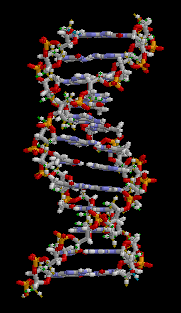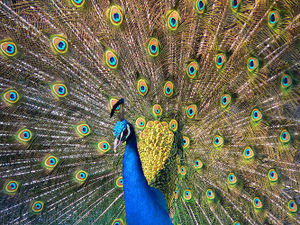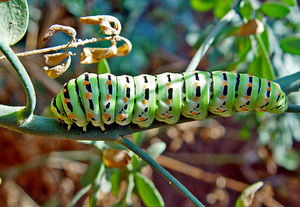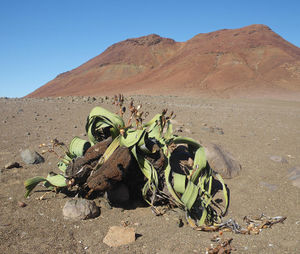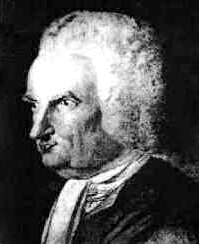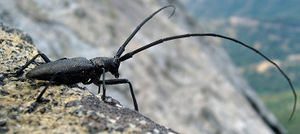Natural selection
Contents
- 1 Introduction
- 2 Natural Selection as a Process
- 3 Genetic Basis of Phenotypic Variation and Heritability
- 4 Changes in Trait Frequency From One Generation to the Next
- 5 Sexual selection
- 6 Evolution
- 7 Limits to Natural Selection
- 8 Patterns of Natural Selection
- 9 Brief History of the Idea
- 10 Further Reading
Introduction
Early lifeforms such as the trilobites altered their traits via natural selection. Natural selection Natural selection is an agent of microevolutionary change in which a population of an organism (Natural selection) becomes better adapted to its habitat by genetic inheritance of advantageous traits resulting in enhanced survival of indiviuals with superior fitness and reproductive success. The process of natural selection has played a key role in the production of the amazing amount of phenotypic diversity observed among organisms.
While the theory of natural selection appears to apply well to most organisms and the primitive origins of life, there are significant diffculties in generalizing the concept to apply to all higher life forms in all aspects of species phenotypic characteristics.
Natural Selection as a Process
Natural selection is a process whereby the environment influences a population's genetic and phenotypic characteristics, such that its members become more suited to that environment. Natural selection occurs if three conditions are satisfied:
- There is variation in a trait among individuals in a population,
- This variation in the trait is at least partially heritable (i.e., it has a genetic basis that is passed from parents to offspring), and
- This variation in traits affects fitness, survival, fecundity (the number of offspring produced), and/or mating ability.
If these conditions are met, then the frequency of the trait in the population will statistically and stochastically advance in the ability to persist in its habitate to from one generation to the next, assuming that the habitat is not altered in ways that introduce new stresses to which the population is not already adapted.
Genetic Basis of Phenotypic Variation and Heritability
Both the phenotypic variation and heritability required for natural selection to occur have a genetic basis. Variation in traits among individuals in a population can occur because different individuals have different forms of the same genes (i.e. DNA sequences) or because they are found in different environments and thus experience different ecological pressures. To the extent that a trait is determined by genes, rather than the environment, the trait will be heritable. Offspring tend to resemble their parents because they receive genes from both parents.
Changes in Trait Frequency From One Generation to the Next
Genes get passed on from one generation to the next by reproduction. Genes that produce traits that allow organisms to be better at surviving and reproducing than other individuals in the population should get passed on more often than genes that produce traits that make the organisms inferior to others at surviving or reproducing. Thus, over time we would expect genes that produce traits that make organisms better at surviving and reproducing to become more common in the population such that the population as whole becomes “better adapted” to its environment. Because conditions vary among environments, it is not surprising that the traits that maximize survival and reproduction differ among environments.
Sexual selection
Sexual selection is a category of natural selection in which characteristics specifically relating to reproduction are involved in the set of traits undergoing selection. In the animal kingdom, the concept is most often applied to characteristics that are utilized in attracting a mate of the greatest fitness. The theory is that individuals with the highest sexual appeal will have more opportunities to produce offspring and will produce more fit offspring, which will aid in the species adaptation. An obvious by-product of this reproductive success is the outcome of a higher percentage of the population that possesses the original trait of superior sexual attraction. One of the most common examples set forth is that of the male peacock, who has developed a complex and attractive plumage for mate attraction, even at the expense of hindering movement by the massive plumage.
Darwin's Paradox reflects on a fundamentally irreconcilable problem with natural selection with regard to the subset of sexual selection processes. Placed in its simplest form, one asks how the apparent attractiveness of certain male characteristics (e.g. bright plumage of some bird species) can both enhance the ability of such males to attract partners and yet provide adequate defence from predators, who can use the same prominent plumage as detection cues.
Evolution
Natural selection is one of the two driving mechanisms of evolution, the other process being genetic drift. The compelling logical process of natural selection is clear in producing adaptive changes within a species, such that it evolves to be more competitive in its environment. In contrast, genetic drift can be viewed as a randomization process, since it depends upon mutations or alteration of a DNA sequence, and the likelihood of a genetic drift becoming a permanent part of the population's makeup relates more to chance than to adaptive forces.
Genetic drift is only significant when altered traits do not strongly contribute to fitness or survival, and such randomizing is merely a stochastic artifact of the organism's journey through the millennia. Thus, in a meaningful sense, natural selection can be viewed as the more powerful of the two evolutionary forces, since it is driven by real consequences in fitness and reproductive efficiency traits. The concept of co-evolution is a closely related one, and simply means that two interdepent species (such as predator/prey or symbionts) are driven to evolutionary outcomes by their combined natural selection (or genetic drift) progression.
Limits to Natural Selection
The process of natural selection would be expected to cease if any of the three assumptions are not met. For example, we might expect that genes that code for phenotypes with higher survival or reproduction would get more common in the population until all individuals in the population have these genes (the gene is “fixed” in the population). If this occurred, natural selection should cease because of the lack of a genetic basis for phenotypic variation within a population. However, because environmental conditions are often quite variable in time and space, genetic variation is rarely if ever completely purged to this extent.
Besides the paradox noted above in regard to sexual selection, there are two other exceptions or flaws in the theory of natural selection. The first is a technical argument, which asks why a beneficial novel genetic mutation will have over-riding consequence versis a random mutation that arises later to obliterate the survival advantages of the earlier mutation. This question simply argues to the timeframes of successive mutations, where empirical data simply cannot support a complete answer from the present state of scientific knowledge.
The second paradox is usually called the Oedipus Paradox and applies only to humans. In this argument it is questioned whether the human species interacts with natural selection processes through altruism or other free will acts, which may overpower the process of natural selection. This argument progresses to point out that pure natural selection in the human species would lead to survival and even rule by the strongest to the possible disenfrachisement of less fit, with the extreme possible outcome of discrimination against the evolution of a democratic society.
The process of natural selection would also cease if phenotypic variation no were longer related to differences in survival or reproduction.This also is unlikely, except in the case of the human species or any species in which humans are intervening in destruction or conservation.
Even though natural selection should cause traits that increase survival and reproduction in an environment to increase in a population, we should not expect that all organisms will be “perfectly adapted” to their environment, for several reasons. First, it is possible that a genetic mutation that would allow organisms to produce a better adapted trait has not appeared in the population. Second, trade-offs and constraints among different traits may limit the ability of any single trait to become perfectly adapted, either because the same genes influences many other traits, because a single trait is involved in multiple functions, or because optimizing one trait leads to a decline in performance of another genetically linked trait.
Patterns of Natural Selection
Natural selection can lead to three patterns of change in phenotype over time:
- Directional selection. If the survival and reproduction (fitness) of organisms with one extreme phenotype is higher than that of organisms with the population's mean phenotype, then the trait frequency will move in the direction of the favored extreme phenotype over time. The net result of directional selection is a directional change in the mean trait value over time.
- Stabilizing selection. If the fitness of organisms with the mean phenotype is greater than the fitness of organisms with either of the extreme phenotypes then over time the mean phenotype should not change but phenotypic variation should be reduced.
- Disruptive selection. If the fitness of organisms with extreme phenotypes is greater than the fitness of organisms with the mean phenotype, then over time a unimodal trait distribution should be converted into a bimodal trait distribution.
Brief History of the Idea
In the pre-Darwinian era of the 18th century English geologist William Smith noticed that rocks of varying ages and orignins preserved different fossil assemblages, which succeeded in a systematic sequence. He was the first to state the principle of faunal succession, based upon fossil sequence observations.
Smith expressed no awareness of biological evolution, and he did not speculate why faunal succession occurred. His contemporary Lord Monboddo, in nearby Scotland, was expressing a clear recognition of evolutionary sequences and hinted at natural selection; Monboddo also carried out extensive selective breeding work, but the two are not known to have communicated. Biological evolution would later explain that faunal and floral succession exists. Faunal change and succession was one of the chief pieces of evidence cited by Darwin that natural selection had occurred.
Although Charles Darwin is the name most associated with the idea of natural selection, his predecessors above had clearly laid the groundwork for this important concept. Alfred Russel Wallace independently came up with essentially the same idea, and he and Darwin agreed to jointly present their ideas to the Linnean Society in 1858. Darwin applied the term Natural Selection to show its relationship with artificial selection that had been carried out by human animal and crop breeders. However, he thought that the term “survival of the fittest”, which was forwarded by Herbert Spencer was “more accurate and sometimes equally convenient.” Darwin recognized that selection had produced traits that did not aid in survival, but aided in attracting mates; he called the process that produced these traits "sexual selection". Today we consider sexual selection to be part of the process of natural selection.
Further Reading
- Charles J..Darwin. 1979. The Illustrated Origin of Species (abridged and introduced by R.E. Leakey). Hill and Wang, New York. ISBN: 0809057352
- .J.A.Endler. 1986. Natural Selection in the Wild. Princeton University Press, Princeton, NJ. ISBN: 0691083878
- D.J.Futuyma. 1998. Evolutionary Biology, 3rd Edition, Sinauer, Sunderland, MA. ISBN: 0878931899
- William Knight. 1900. Lord Monboddo. John Murray. London. 314 pages
- T.Dobzhansk. 1968. On some fundamental concepts of evolutionary biology. Evolutionary biology 2, 1–34
- George C.Williams. 1966. Adaptation and natural selection: a critique of some current evolutionary thought. Princeton Science Library. "Evolutionary adaptation is a phenomenon of pervasive importance in biology".
- C. Michael Hogan. 2008.California Buckeye: Aesculus californica, GlobalTwitcher.com, N. Stromberg ed.
- James H.Brown and Astrid Kodric-Brown Astrid. 1979. Convergence, Competition, and Mimicry in a Temperate Community of Hummingbird-Pollinated Flowers. Ecology vol 60, issue 5
